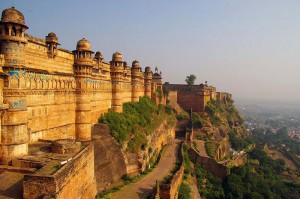 If you want to see examples of the traditional antiques of a royal family, visit Gwalior. Known for its rich cultural heritage, the city of Gwalior has played an integral role in Indian history from ancient times, through the medieval era, and later during the Moghul and British colonial rule. The bustling city atop a hill, is dominated by the Gwalior fort which has been the battleground for many struggles for power. Gwalior with its famous fort held a strategic position in the region of north India. The city was the capital of the ruling kingdom and the principality of the Maharajas of Scinidia. When you arrive in Gwalior, you need to visit Gwalior Fort and the city Palace of Scinidia, which houses traditional antiques of the royal family.
If you want to see examples of the traditional antiques of a royal family, visit Gwalior. Known for its rich cultural heritage, the city of Gwalior has played an integral role in Indian history from ancient times, through the medieval era, and later during the Moghul and British colonial rule. The bustling city atop a hill, is dominated by the Gwalior fort which has been the battleground for many struggles for power. Gwalior with its famous fort held a strategic position in the region of north India. The city was the capital of the ruling kingdom and the principality of the Maharajas of Scinidia. When you arrive in Gwalior, you need to visit Gwalior Fort and the city Palace of Scinidia, which houses traditional antiques of the royal family.
Find Hotels In Gwalior
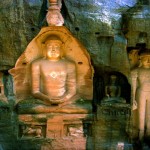 The strategically important fort at Gwalior dominates the city and for centuries it controlled one of the major routes between north and south India. Its history goes back to 2000 years, with rock inscriptions from the 5th century still to be found. From the 12th century control of the fort and surrounding area passed through a succession of Muslim, Tomar Rajput, Afghan, Mughal and finally Maratha rulers. During the 12th century Qutb-ud-din Aibak was the first ruler to hold it but eventually the Tomars took possession. It was under Man Singh who came to power in 1486 that many of the great battlements and interior palaces were built. After a short period of control by Lodhis, the first Mughal emperor took over the fort, and described it as a “Pearl among the fortresses of Hind”. During the collapse of Mughal empire, the Scindia line of Marathas conquered the area in 1754. The British took control of it during the Maratha wars and held it for 30 years after capturing the Rani of Jhansi within its walls in 1858.
The strategically important fort at Gwalior dominates the city and for centuries it controlled one of the major routes between north and south India. Its history goes back to 2000 years, with rock inscriptions from the 5th century still to be found. From the 12th century control of the fort and surrounding area passed through a succession of Muslim, Tomar Rajput, Afghan, Mughal and finally Maratha rulers. During the 12th century Qutb-ud-din Aibak was the first ruler to hold it but eventually the Tomars took possession. It was under Man Singh who came to power in 1486 that many of the great battlements and interior palaces were built. After a short period of control by Lodhis, the first Mughal emperor took over the fort, and described it as a “Pearl among the fortresses of Hind”. During the collapse of Mughal empire, the Scindia line of Marathas conquered the area in 1754. The British took control of it during the Maratha wars and held it for 30 years after capturing the Rani of Jhansi within its walls in 1858.
Place To See In Gwalior
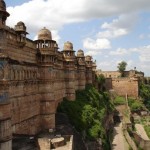 Gwalior Fort : The city’s most renowned landmark Positioned at a height of 100m above the main town of Gwalior around 3 kms in length, this staggering citadel dominates the skyline of the place and is acknowledged as the most impregnable fort in the whole of Central and Northern India. The fort was built by Raja Man Singh Tomar as a token of love for his wife, in the 15th century,The great Mughal Emperor Babur reputedly quote it as, “The pearl in the necklace of the forts of Hind”. The fort is girdled by sandstone walls and stretches over an area of 3 sq km. It houses three temples, six palaces and a large number of water tanks. Among the temples are the beautifuly adorned ‘Sas Bahu Ka Mandir’, Sikh Gurudwara, Jain Temple which has been also been praised as a mosque and the Teli-ka-Mandir. The massive fortress of the Gwalior fort signifies the manifold dynasties of Mughals, Tomars, Britishers and Scindias.This fort have seen the the life of the Buddhist saint Lord Buddha and anecdotes related to the spread of Buddhism. The Chinese dragons that have been crafted at the hilt of the pillars depicts the mutual trade between China and India.
Gwalior Fort : The city’s most renowned landmark Positioned at a height of 100m above the main town of Gwalior around 3 kms in length, this staggering citadel dominates the skyline of the place and is acknowledged as the most impregnable fort in the whole of Central and Northern India. The fort was built by Raja Man Singh Tomar as a token of love for his wife, in the 15th century,The great Mughal Emperor Babur reputedly quote it as, “The pearl in the necklace of the forts of Hind”. The fort is girdled by sandstone walls and stretches over an area of 3 sq km. It houses three temples, six palaces and a large number of water tanks. Among the temples are the beautifuly adorned ‘Sas Bahu Ka Mandir’, Sikh Gurudwara, Jain Temple which has been also been praised as a mosque and the Teli-ka-Mandir. The massive fortress of the Gwalior fort signifies the manifold dynasties of Mughals, Tomars, Britishers and Scindias.This fort have seen the the life of the Buddhist saint Lord Buddha and anecdotes related to the spread of Buddhism. The Chinese dragons that have been crafted at the hilt of the pillars depicts the mutual trade between China and India.
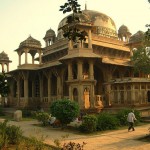 Tansen’s Tomb : The father of Hindustani classical music and one of the nine jewels of Akbar’s court, legendary singer Tansen is buried in Gwalior. Built in the memory of Tansen,the great musician during the time of Mughal. This tomb is situated near the tomb of Saint Hazrat Ghaus and is a part of Gwalior’s cultural heritage .The headstone is surrounded by beautiful gardens on all its sides. Apart from being an ancient monument, the site also underlines the rich cultural heritage of Gwalior. It is an excellent tourist destination and is also addressed as the hall to annual Tansen Music Festival.Every year in the month of November/ December, a national level music competition is held at the place, to venerate this great musician.
Tansen’s Tomb : The father of Hindustani classical music and one of the nine jewels of Akbar’s court, legendary singer Tansen is buried in Gwalior. Built in the memory of Tansen,the great musician during the time of Mughal. This tomb is situated near the tomb of Saint Hazrat Ghaus and is a part of Gwalior’s cultural heritage .The headstone is surrounded by beautiful gardens on all its sides. Apart from being an ancient monument, the site also underlines the rich cultural heritage of Gwalior. It is an excellent tourist destination and is also addressed as the hall to annual Tansen Music Festival.Every year in the month of November/ December, a national level music competition is held at the place, to venerate this great musician.
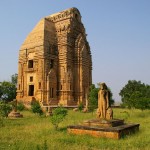 Teli Ka Mandir : This religious place marks the presence of Lord Vishnu in the earth. Built in the 9th century AD, it towers at a height of 100ft. According to legends, the temple is so named as it is believed to be fabricated in the ‘Telangana’ architectural style. The temple’s architecture, design and layout features an outstanding fusion of architectural styles. The roof of the temple resembles a Dravidian style while the entire decorations highlights the art of North Indian.The temple exhibit a circular barrel,also called shikar and provides a stunning sight.
Teli Ka Mandir : This religious place marks the presence of Lord Vishnu in the earth. Built in the 9th century AD, it towers at a height of 100ft. According to legends, the temple is so named as it is believed to be fabricated in the ‘Telangana’ architectural style. The temple’s architecture, design and layout features an outstanding fusion of architectural styles. The roof of the temple resembles a Dravidian style while the entire decorations highlights the art of North Indian.The temple exhibit a circular barrel,also called shikar and provides a stunning sight.
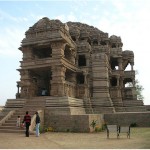 Saas-Bahu Temple : The Saas-Bahu temple dedicated to Lord Vishnu is also a major landmark of Gwalior. Built in 11th century, the name of the temple can be quite misleading. The temple, as many people believe, is not dedicated to ‘Saas’ (mother-in-law) and ‘Bahu’ (daughter-in-law). The name metaphorically and traditionally implies to two temples of different sizes adjoined to each other. The larger is more elaborately patterned with intricate artwork and attractive sculptures. The detailing and the beautiful interior of the temple, especially the roof which exhibits carved lotus, attract many tourists throughout the year.
Saas-Bahu Temple : The Saas-Bahu temple dedicated to Lord Vishnu is also a major landmark of Gwalior. Built in 11th century, the name of the temple can be quite misleading. The temple, as many people believe, is not dedicated to ‘Saas’ (mother-in-law) and ‘Bahu’ (daughter-in-law). The name metaphorically and traditionally implies to two temples of different sizes adjoined to each other. The larger is more elaborately patterned with intricate artwork and attractive sculptures. The detailing and the beautiful interior of the temple, especially the roof which exhibits carved lotus, attract many tourists throughout the year.
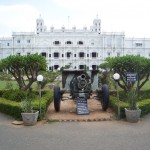 Jai Vilas Palace : Though Jai Vilas Palace is the current residence of the Scindia family;about 35 of its palatial rooms have been converted into the ‘Scindia Museum’. The architectural style of this imperial structure is dominantly Italian, with a fine blend of Corinthian and Tuscan architectural modes. Handpicked royal treasures and historical artifacts from different countries are displayed in the museum. The most striking one is a silver train, with cut-glass wagons and miniature rails, which chugged along dinner tables and was used to serve food to the guests.The enormous Jai Vilas Palace built in the 19th century has a pair of world’s heaviest chandeliers in the Durbar Hall, and a crystal staircase.
Jai Vilas Palace : Though Jai Vilas Palace is the current residence of the Scindia family;about 35 of its palatial rooms have been converted into the ‘Scindia Museum’. The architectural style of this imperial structure is dominantly Italian, with a fine blend of Corinthian and Tuscan architectural modes. Handpicked royal treasures and historical artifacts from different countries are displayed in the museum. The most striking one is a silver train, with cut-glass wagons and miniature rails, which chugged along dinner tables and was used to serve food to the guests.The enormous Jai Vilas Palace built in the 19th century has a pair of world’s heaviest chandeliers in the Durbar Hall, and a crystal staircase.
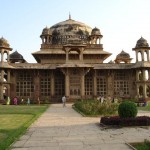 Mausoleum of Ghaus Mohammed : The sandstone mausoleum of the Afghan prince Ghaus Mohammed, Located in the old town of Hazira.Tthe ‘Afghan Prince turned Sufi Saint’ who helped Babur in annexing the Gwalior Fort. Built in the 16th century, this sandstone tomb is an exemplary piece of Mughal architectural adroitness. Built opulently in early Mughal lines, the screens of the monument have been carved using the pierced stone technique. Thus, these fine trellises look like delicate and exquisitely patterned laces. The beauty of the monument is also enhanced by the dappling gardens that surround it.
Mausoleum of Ghaus Mohammed : The sandstone mausoleum of the Afghan prince Ghaus Mohammed, Located in the old town of Hazira.Tthe ‘Afghan Prince turned Sufi Saint’ who helped Babur in annexing the Gwalior Fort. Built in the 16th century, this sandstone tomb is an exemplary piece of Mughal architectural adroitness. Built opulently in early Mughal lines, the screens of the monument have been carved using the pierced stone technique. Thus, these fine trellises look like delicate and exquisitely patterned laces. The beauty of the monument is also enhanced by the dappling gardens that surround it.
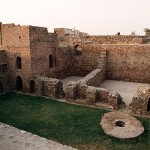 Gujari Mahal : Gujari Mahal is fascinating as it portrays the King’s love and admiration for the beautiful and bold Mrignayani, which is now part of folklore. The place now converted onto a museum is known for its collection of Jain and Hindu artifacts and rare collection of stone carvings and other art works. . The Fort is also known for the temples in its precincts.
Gujari Mahal : Gujari Mahal is fascinating as it portrays the King’s love and admiration for the beautiful and bold Mrignayani, which is now part of folklore. The place now converted onto a museum is known for its collection of Jain and Hindu artifacts and rare collection of stone carvings and other art works. . The Fort is also known for the temples in its precincts.
Near By Attraction Gwalior
Shivpuri : 114 kms from Gwalior is the old summer capital of Scindias. Set in formal gardens, the Chhatris (tombs) are the main attraction here. With Mughal pavilions and sikhara spires these beautiful memorials to the Scindia rulers are inlaid in Pietra dura style like the Taj Mahal.
Daita : Daita is known for its seven-storied palace of Raja Bir Singh Deo built atop a hill. This unique structure was known in Mahabharata as Daityavakra. The other interesting sights are Gopeshwar Temple and the tantric peeth of Pitambara Devi.
Dholpur : Between Gwalior and Agra, in a part of Rajasthan that separates Madhya Pradesh and Uttar Pradesh, Dholpur was the scene of a pitched battle between Aurangzeb’s sons for inheritance of the emperor’s throne. There is a very old fort called Shergarh Fort, which is now in ruins.
Sonagiri : Sonagiri is a sacred place of Digambar Jains. It has several white Jain temples around it. King Nanganang Kumar, along with his 15 million followers, achieved liberation at this place.
Tigra dam: Tigra dam is a famous picnic spot, which is constructed on the river Chambal. It is located 23 km away from the city of Gwalior.
How To Reach Gwalior
AIR : Gwalior Airport (8 kms from the main city) is connected by Indian Airlines to Bombay, Bhopal, Indore, and Delhi. The services are operational three days a week. Air Deccan to and from Delhi, Indore and Bhopal to Gwalior’s airport. Indian Airlines Delhi to Jabalpur line also stops at Gwalior.
RAIL : Gwalior is on the Central Railway’s main Delhi-Mumbai and Delhi-Chennai lines. It iis connected with all major cities in India.Gwalior is very well connected to major cities across India by direct train links. You can reach Gwalior from India’s capital New Delhi, in 3 hours by New Delhi-Bhopal Shatabdi Express(India’s fastest train).
Road : Gwalior is fairly well connected to other parts of Madhya Pradesh and India with national and state highways. The Agra-Bombay national highway (NH3) passes through Gwalior. The Agra-Bombay Road runs though the city connecting it to Shivpuri on one end and Agra on the other. The city is connected to the Jhansi by the National Highway 75, towards the south of the city. In the Northern, the city is connected to the holy city of Mathura via National Highway 3. There are bus services to and from all major and minor cities near Gwalior. The prominent one being Bhopal, Agra, Delhi, Jabalpur, Jhansi, Bhind, Morena, Datia, Jaipur and Indore.
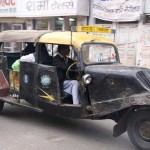 Local transport :Tempos cheapest way to move inside the city, but you may need to share it with other passengers. Gwalior’s public transport system consists of tempos and horse drawn tongas (which run fixed routes much like a bus system) and auto rickshaw taxis. Recently the municipal corporation has launched Gwalior City Bus covering some routes in the city.
Local transport :Tempos cheapest way to move inside the city, but you may need to share it with other passengers. Gwalior’s public transport system consists of tempos and horse drawn tongas (which run fixed routes much like a bus system) and auto rickshaw taxis. Recently the municipal corporation has launched Gwalior City Bus covering some routes in the city.
Facts About Gwalior
Population : 780,000
Main Languages : Hindi.
Telephone area code : 0751
Best time to visit : October to March
Weather : Summer 24°C-45°C
Winter 6 degress Celcius and 21°Cs
Image Gallery Of Gwalior
Submit your review | |































![Reblog this post [with Zemanta]](http://img.zemanta.com/reblog_e.png?x-id=f9a950fd-efed-44fb-b637-b2ef798bcb89)

Hi, nice post. I just found this blog, but I will definitely visit regularly. Keep us updated.